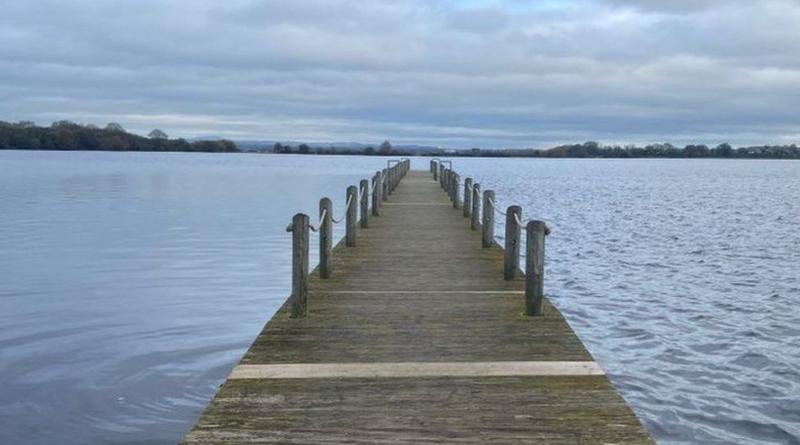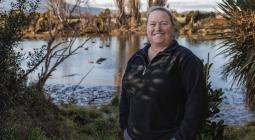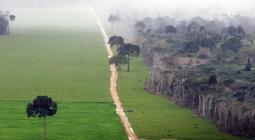Lough Neagh: Too soon to tell ecological impact of algal blooms - experts

Warning signs about blue-green algae are still in place in Mid-Ulster facilities surrounding Lough Neagh.
However, last week signs were removed from Oxford Island, with signage at Rea's Wood, County Antrim, expected to be removed this week.
The toxic algae was found throughout the lough, which provides 40% of Northern Ireland's drinking water, over the summer.
The ecological impact on the lake remains unknown at this time.
'Dropped the ball'
Chairman of the Ulster Angling Federation, Gary Houston, said the presence of blue-green algae was nothing new to the lough and that water quality has been declining from the 1960s.
He claimed the Agri-Food and Biosciences Institution (Afbi) and the Northern Ireland Environment Agency (NIEA) had "dropped the ball" in terms of monitoring and managing the lough.
"The population of the Lough Neagh fly is very iconic and the whole population has just collapsed and no one has been monitoring it," he said.
"From angling observations we know that the trout have ran back into the rivers and both these and the eels appear skinny".
Mr Houston said he had attended meetings with NIEA but felt no action had been taken, with him believing the algal blooms may be worse next summer.
An NIEA spokesperson said environmental monitoring is undertaken in and around the lough, with Afbi also conducting research projects.
They said the flies were not previously monitored as they were "commonplace and not a protected feature" but the agency acknowledged they are "a key trophic (food) component of the Lough Neagh ecosystem".
"A count of the Lough Neagh fly is only one of potentially hundreds of parameters which could be monitored.
"It is clear that introduced species such as zebra mussels and roach are contributing to ecosystem change in conjunction with pressures such as nutrient enrichment and climate change."
Lough Neagh Partnership Manager, Gerry Darby said even before this year's blooms, the decrease in fly life was evident.
"There used to be so many of them and you could almost see them like plumes of smoke but they have reduced to virtually zero," he said.
"They are obviously a food source for the birds, the fish and the eels."
Mr Darby said there has also been a "collapse" in the number of breeding wading birds, which are monitored by the partnership.
"The solution will not be found in the lough, it will be in the many catchments which feed into it," he said.
"I think that the blue-green algae was seen as such a big crisis because you could see it but the other multitude of problems are not seen."
Dr Adam Mellor from Afbi, which has been monitoring the algae, said it had not died out with high cell counts still being found.
"It's still loitering, and I think we're still perhaps going to require a little less daylight hours and a little lower temperatures to really take it down."
Dr Mellor said it is not yet known what impact the algae will have had on the ecosystem but changes in the lough had observed prior to this year's bloom.
"We've been damaging the ecosystem in Lough Neagh now for 60 years or so and we've been doing it knowingly for 50 years, but we've got away without the acute impacts," he said.
"Although nutrients are essential, we need them in the water, and on the land to grow food but it is the surplus that is the problem."
'Crunch point'
Dr Mellor explained Afbi's work is to use science and modelling to inform what can be proposed or adopted to manage the nutrients.
"All the science does is inform, after that it is down to politics and economics and public will," he added.
"We have observed for years, there's been increases in the zebra mussel, there's decreasing juvenile fish success, there's changes to the lough, over the last five or six years the decline in the lough fly has been well documented and the Mysis shrimp has more or less disappeared from our surveys."
However, Dr Mellor said none of these could be directly attributable to this year's bloom.
"There could be other unknown factors that we're not aware of but things now really have got to that crunch point, we've reached a threshold for people to care where hopefully we think about how we live with our environment."
A Department of Agriculture, Environment and Rural Affairs (Daera) spokesperson said: "This is a complex, multi-factoral issue that will take years, if not decades, to improve.
"Part of that improvement pathway is to review the impact of current policies and interventions and exploring what we can do better in the short, medium and long term."
They added the department had pulled together a panel of experts "tasked with developing recommendations that will put Northern Ireland on a clear pathway to achieving improved water quality following the blue green algae detections over the summer"
"DAERA will look at all feasible options, but recommendations for action will have to be considered in the context of competing budgetary demands across the public sector and, in due course, the priorities of a returning Executive."





